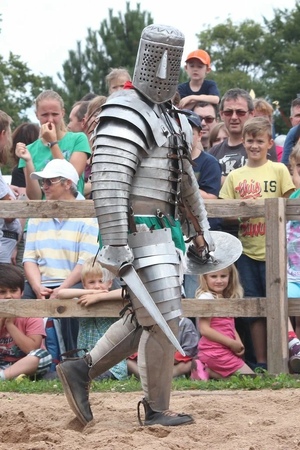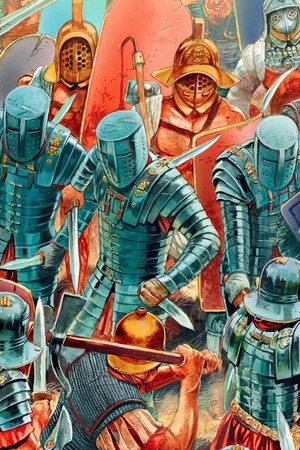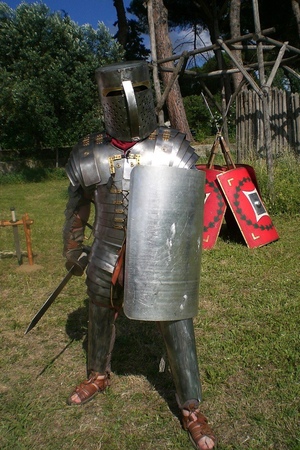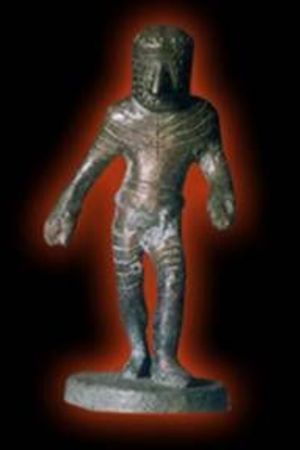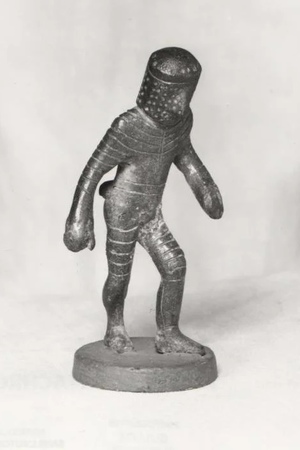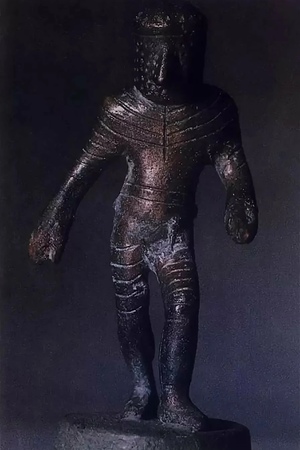Crupellarius
Crupellarius (Latin: crupellarius) was the most heavily armed gladiator, whose armor consisted of a lorica segmentata, manica on both arms, and high segmented greaves up to the thighs. The helmet was typical for ancient Roman gladiators, completely covering the head and face with only small openings for the eyes and mouth; externally, it vaguely resembles a medieval "topfhelm" helmet. In terms of protection, the crupellarius surpassed not only other gladiators of that time but also any ancient warrior in general. Fully covered in metal, it resembled more of a medieval knight rather than a representative of the ancient era. Thus, the crupellarius gladiator was practically invulnerable to opponents. It is assumed that his armament consisted of a scutum and gladius, similar to the provocator. The level of physical training for crupellarii was very high, as wearing heavy armor required immense strength and endurance.
There are very few mentions of crupellarii, and it is believed that this type of gladiator was not widely spread in antiquity, possibly due to the fact that among spectators of gladiatorial combat, high protection and body coverage were unpopular. Only two sources of information about such warriors have survived to this day: a bronze statuette and a mention in the "Annals" by the Roman historian Tacitus.
Tacitus writes that crupellarii were recruited from Gallic slaves equipped in the tradition of gladiators from Lugdunum Gaul, who participated in the rebellion of the Treviri under the leadership of Julius Florus and Julius Sacrovir in 21 AD during the reign of Emperor Tiberius. The rebellion was triggered by the high debts of local Gauls, which they refused to pay. Among the rebels, Tacitus mentions heavily armored Gallic gladiators who were called crupellarii. The decisive clash between the Aedui and the Roman army took place near Augustodunum (modern-day Autun in France). Sacrovir relied heavily on the crupellarii in his tactics, positioning them in the center at the front, while the other rebels were positioned alongside and behind, providing cover for the heavily armed gladiators. It was the Gallic gladiators-crupellarii who offered the strongest resistance to the Romans, being virtually invulnerable to weapons. The legionaries had to resort to axes and picks that were not intended for direct combat:
"43. ... Forty thousand men joined his [Sacrovir's] forces, of whom one-fifth were armed after the Roman fashion, while the rest had nothing but slings, knives, and similar weapons used by hunters. With them were combined a band of slaves, such as is usual among the tribe, tightly clad in iron armor and so called Crupellarii, useful for attack only to a slight extent, but invulnerable to the blows of their foes. ... 46. ... The destruction of the Aedui was somewhat delayed by the heavy armor of the legionaries, for the enemy's blows made no impression on their breastplates or helmets; but seizing axes and mattocks, they battered in the plates as if they were battering down a wall, others knocked these heavy masses down to the ground with long poles and forks, and they lay as though lifeless, and with no attempt to rise." - Annals III, 43; 46
In 1972-74, in Versigny (Picardy region), a bronze statuette was found, initially labeled by archaeologists as a figurine of an unknown warrior. It is dated to a period that coincides with the uprising of Gallic gladiators. Later, it was identified as a figurine of a crupellarius—a heavily armored Gallic gladiator. Currently, the figurine is housed in the museum of the city of La Fer, France.
